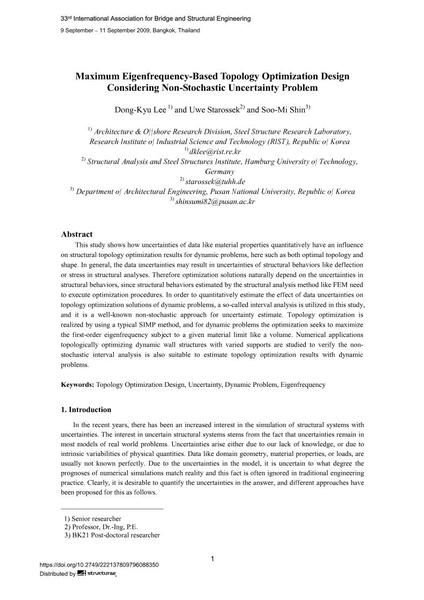Maximum Eigenfrequency-Based Topology Optimization Design Considering Non-Stochastic Uncertainty Problem

|
|
|||||||||||
Bibliografische Angaben
| Autor(en): |
Dong-Kyu Lee
Uwe Starossek Soo-Mi Shin |
||||
|---|---|---|---|---|---|
| Medium: | Tagungsbeitrag | ||||
| Sprache(n): | Englisch | ||||
| Tagung: | IABSE Symposium: Sustainable Infrastructure - Environment Friendly, Safe and Resource Efficient, Bangkok, Thailand, 9-11 September 2009 | ||||
| Veröffentlicht in: | IABSE Symposium Bangkok 2009 | ||||
|
|||||
| Seite(n): | 250-262 | ||||
| Anzahl der Seiten (im PDF): | 13 | ||||
| Jahr: | 2009 | ||||
| DOI: | 10.2749/222137809796088350 | ||||
| Abstrakt: |
This study shows how uncertainties of data like material properties quantitatively have an influence on structural topology optimization results for dynamic problems, here such as both optimal topology and shape. In general, the data uncertainties may result in uncertainties of structural behaviors like deflection or stress in structural analyses. Therefore optimization solutions naturally depend on the uncertainties in structural behaviors, since structural behaviors estimated by the structural analysis method like FEM need to execute optimization procedures. In order to quantitatively estimate the effect of data uncertainties on topology optimization solutions of dynamic problems, a so-called interval analysis is utilized in this study, and it is a well-known non-stochastic approach for uncertainty estimate. Topology optimization is realized by using a typical SIMP method, and for dynamic problems the optimization seeks to maximize the first-order eigenfrequency subject to a given material limit like a volume. Numerical applications topologically optimizing dynamic wall structures with varied supports are studied to verify the non- stochastic interval analysis is also suitable to estimate topology optimization results with dynamic problems. |
||||
| Stichwörter: |
Eigenfrequenz Unsicherheit
|
||||
